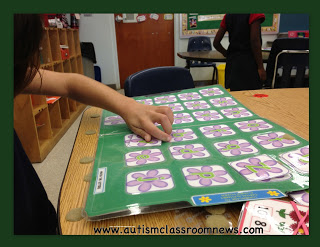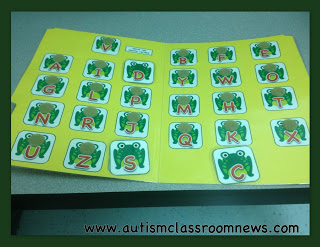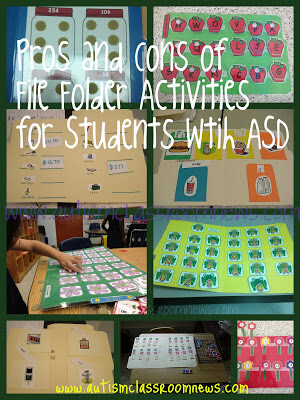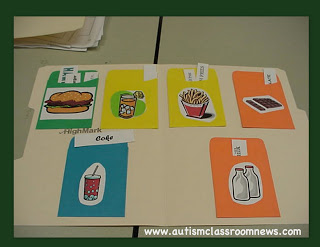Sharing is caring!
File folder games are such an easy type of activity for use in the classroom for a variety of reasons, but there are good points and not so good points for many students with autism. Don’t get me wrong; I still love them (and create them), but there are some things to consider about using them.
Pros:
1. They are self-contained tasks.
Everything you need is attached to the file folder, so it has its own container.This makes them highly portable and easy for students to access.
2. Students like them.
Typically file folder activities are fun and engaging and can incorporate special interests and can teach the same skills repeatedly with different materials cheaply.
3. They can be changed out with themes.
If you use themes in your classroom for planning instruction, file folders are easy to build into those themes and keep materials engaging for students.
For instance, the two examples below are both part of file folder activities I sell on TPT that all focus on basic matching skills of letters, numbers, sets and other common core curriculum skills for early childhood and complex learners. One set is set up for flowers and the other for frogs and are designed for spring themes, while there is a beach file folder and Fourth of July set for summer (I’m working on fall and winter now). They all address variations of the same skills but they have different materials for doing it.
When I have finished adding all the materials to the growing Autism Basic Skills Matching Bundle, there will be sets of file folders (and some task cards) for matching letters, numbers and colors for all 4 seasons so that students who are working on learning and maintaining these skills during the year will have different sets of materials to do it.
4. They capitalize on visual strengths.
Students with autism often (not always) have strength in visual-perceptual skills. The visual nature of the tasks they complete with file folder activities play up to these strengths. They can be used to help them practice more abstract skills (like receptive language) but typically they involve sorting, matching or some other type of visual skill that they are good and enjoy. This also makes file folder activities good for practicing skills independently and for independent work systems.
Cons:
1. Students memorize them.
This is probably my biggest problem with file folders. I work with students who frequently memorize the answers. So for instance, in the picture below, the middle school student used a flyer to find the prices and put them next to the items. The problem was, because other flyers didn’t have the same items and the flyer couldn’t be changed out, he memorized the answers from the flyer and bypassed the point of the task to just write down the prices from top to bottom. He could memorize the answers to file folder games faster than we could make them.

One solution to this is to make tasks that don’t have fixed pieces. I wrote about setting file folders up with the bottom pieces being movable in another post last year but essentially you create the file folder that looks like the one below. In this activity, the numbers for the math problems change and the student uses different colored pieces to put in the answers. This was for the same student who memorized so it kept him from just being able to go down the rows and put in the answers without doing the problems.
Another option is to do sorting tasks using library pockets so the order of the materials change frequently like the one below that are set up to correspond to Edmark Functional Word Series lessons.
2. Pieces go missing.
Always. Always! You can count on it. And once the pieces are missing, if you are doing a matching file folder, you can’t do it until you replace them because so many students get upset when all the pieces aren’t there to complete it.
Check out this post about fastening a zip lock bag to the back of a folder with packing tape so it lies flat and stays attached to hold the pieces. Always consider making an extra set when you make them as well so you can fix it quickly if needed.
3. You have to make sure they teach the skill you intend.
I talked about this issue in an earlier post as well, but it is something that we really have to remember with students on the spectrum. They often attend to different things than we intend. My favorite example is a picture that has many things that are absurd about it (e.g., a dog on a surfboard, it’s only raining on the cat in the picture but no one else) and you ask the student with ASD about what is wrong with the picture and he tells you there is something terribly wrong. Excited that he seems to get it, you ask, what? And tells you there are 3 grains of sand in the bottom corner of the picture that a different color than the rest. Um, yeah, not what I was going for. Many file folder activities combine characteristics. For instance, the 1 is red, the 2 is blue, the 3 is yellow. Then when the student goes to match them, you don’t really know if he is matching the colors or the numbers. That is why the file folders I create, like
Jumping into Spring below, all have the same picture for all the numbers and all the letters, so you know that when they are matching the numbers, it’s the numbers that are matching up, not the color or picture.
So, as you can see I see more pros than cons which is why I continue to create and use file folder activities. They are just too easy to use to abandon them and they are too cute not to use in the classroom because they can fit into so many themes that are being worked on. What do you see as the pros and cons of file folder activities with your students? Sound off in the comments!
Until next time,














